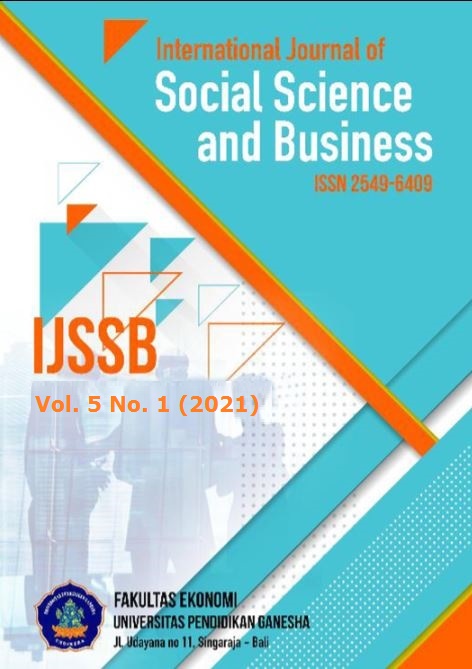The Process and Meaning of the Manusa Yadnya Ceremony for the Hindu Bali Community
DOI:
https://doi.org/10.23887/ijssb.v5i1.29279Keywords:
procession, life cycle, yadnya ceremonyAbstract
The Balinese Hindu community interpret life as a process of transformation that must always be interpreted and treated. According to the beliefs of the Balinese Hindu community, the process of the life cycle to achieve the perfection of life must go through various stages of the procession of the ceremony (the ceremony of manusa yadnya). Life cycle ceremony processions carried out since the fetus is still in the womb, born, large, adult, old, even to death. It is believed that it is not only the body that needs nutritionally complete and balanced food in its growth and development. Spiritual must also be given spiritual food to build spiritual growth itself toward a healthy, strong and steady spirit. The life cycle ceremony process is a process of spiritual self-cleansing to lead to physical and spiritual purity. In the Book of Manawa Dharmasastra the life cycle ceremony process is stated as samskara sarira. Sarira samkara means a ceremony to increase the sanctity of one's body through the process of yadnya (holy sacrifice) ceremony. To achieve this increase should be balanced growth between the body (sarira) physical and spiritual. Corresponding to that, then studying the ceremonial procession and the meaning of the ceremony procession of the Hindu Balinese human life cycle is something very urgent.
References
Adnyana, I. W. A. (2020). Nilai Pendidikan Tattwa Pada Tutur Parakriya. Jurnal Penelitian Agama Hindu, 4(1), 14–23. http://www.ejournal.ihdn.ac.id/index.php/JPAH/article/view/1276.
Anggraini, P. M. R. (2019). Konsep Cakra Yadnya Terhadap Penggunaan Buah Import di Bali (Studi Kasus Perayaan Hari Raya Galungan). Jñānasiddhânta: Jurnal Teologi Hindu, 1(1). https://stahnmpukuturan.ac.id/jurnal/index.php/jnanasidanta/article/view/345.
Bagus, I. G. N. (1971). Sistem Pola Menetap Masyarakat Bali. Unud Denpasar.
Darma, I. D. P. (2012). Upacara Agama Hindu Di Bali Dalam Perspektif Pendidikan Konservasi Tumbuhan.(Suatu Kajian Pustaka). Buletin Udayana Mengabdi, 7(1). https://ocs.unud.ac.id/index.php/jum/article/view/1930.
Darmawan, I. P. A. (2020). Estetika Panca Suaradalam Upacara Yadnya di Bali. Jñānasiddhânta: Jurnal Teologi Hindu, 2(1), 61–70. http://jurnal.stahnmpukuturan.ac.id/index.php/jnanasidanta/article/view/821.
Dekaka, R. (1994). Pedoman Praktis Pokok-Pokok Pelaksanaan Upacara Manusa Yadnya. Hanuman Sakti.
Dewi, R., & Sudarsana. (2017). Upacara Bayuh Oton Uda Yadnya di Desa Pakraman Sidakarya Kecamatan Denpasar Selatan Kota Denpasar. Jurnal Penelitian Agama Hindu, 1(2). https://core.ac.uk/download/pdf/291675633.pdf.
Gunanta, & Kniten. (2005). Tinjauan Tabuh Rah dan Judi. Paramita.
Hamzah, A. (2019). Metode Penelitian Kepustakaan: Kajian Filosofis, Teoretis, dan Aplikatif. Literasi Nusantara.
Kaler, I. G. K. (1983). Butir-butir Tercecera tentang Adat Bali. Bali Agung.
Lestari, I. A. D., & Sutriyanti, N. K. (2020). Implementasi Pembelajaran Catur Guru Dalam Membentuk Karakter Siswa. Jurnal Penelitian Agama Hindu, 4(1), 81–90. http://ejournal.ihdn.ac.id/index.php/JPAH/article/view/1390.
Lichtman, M. (2013). Qualitative Research in Education (3rd ed.). SAGE Publications.
Lindayanti, N. P. F., Purnamawati, G. A., & Prayudi, M. A. (2020). Analisis Sistem Pengelolaan Keuangan Upacara “Ngaben Aluh” Dalam Melestarikan Kearifan Lokal Budaya Bali. JIMAT (Jurnal Ilmiah Mahasiswa Akuntansi) Undiksha, 11(1), 34–43. https://ejournal.undiksha.ac.id/index.php/S1ak/article/view/24642.
Ngurah, G. (1986). Manusa Yadnya. Majelis Pembina Lembaga Adat Prov. Bali.
Pitriani, N. R. V. (2020). Tattwa dalam Yadnya Perspektif Filsafat Hindu (Siwa Tattwa) bagi Masyarakat Hindu di Bali. ŚRUTI: Jurnal Agama Hindu, 1(1), 45–57. http://jurnal.ekadanta.org/index.php/sruti/article/view/61.
Putra, N. (1988). Upacara Manusa Yadnya. IHD Denpasar.
Renawati, P. W. (2019). Implementasi Upacara Manusa Yadnya Dalam Naskah Dharma Kahuripan (Perspektif Teologi Hindu). Mudra Jurnal Seni Budaya, 34(3), 372–384. http://jurnal.isi-dps.ac.id/index.php/mudra/article/view/796.
Srimad, S. (2006). Bhagavad Gita Menurut Aslinya. The Bhaktivedanta Book Trust.
Suadnyana, I. B. P. E. (2018). Kajian Nilai Pendidikan Agama Hindu Dalam Konsep Manyama Braya. Suadnyana, I. B. P. E., 5(1), 48–60. http://ojs.stahdnj.ac.id/index.php/pasupati/article/view/128.
Suarjana, A. A. G. (2017). Faktor Penentu Minat Berwirausaha Mahasiswa (Suatu Evaluasi Pembelajaran). Jurnal Bisnis Dan Kewirausahaan, 13(1), 11–22. http://ojs.pnb.ac.id/index.php/JBK/article/view/687.
Suastika, I. N., Arta, K. S., & Widiastini, N. M. A. (2019). Folklore and Social Science Learning Model in Elementary School in Bali. Jurnal Kawistara, 9(2), 150–163. https://core.ac.uk/download/pdf/289867734.pdf.
Suastika, I. N., Susila, G. P. A. J., & Widiastini, N. M. A. (2019). Traditional Life Of Bayung Gede Community And Its Development As Cultural Attraction. International Journal of Applied Sciences in Tourism and Events, 3(1), 108–121. http://ojs.pnb.ac.id/index.php/IJASTE/article/view/1227.
Sudarsana, I. K. (2017). Interpretation Meaning of Ngaben for Krama Dadia Arya Kubontubuh Tirtha Sari Ulakan Village Karangasem District (Hindu Religious Education Perspective). Vidyottama Sanatana: International Journal of Hindu Science and Religious Studies, 1(1), 1–13. http://www.ejournal.ihdn.ac.id/index.php/IJHSRS/article/view/148.
Sudirgayasa, I. G., Surata, I. K., Sudiana, I. M., Maduriana, I. M., & Gata, I. W. (2017). Potensi Upacara Keagamaan Hindu Bali Sebagai Media Pembelajaran Biologi. Seminar Nasional Riset Inovatif, 5, 59–65. https://eproceeding.undiksha.ac.id/index.php/senari/article/download/917/656.
Sugiyono. (2018). Metode Peneiltian Kuantitatif, Kualitatif dan R&D. In Alfabeta Bandung.
Titib M. (2000). Theologi & Simbol-Simbol dalam Agama Hindu. Paramita.
Wartayasa, I. K. (2018). Pelaksanaan Upacara Yadnya Sebagai Implementasi Peningkatan dan Pengamalan Nilai Ajaran Agama Hindu. Kamaya: Jurnal Ilmu Agama, 1(3), 186–199. http://jayapanguspress.penerbit.org/index.php/kamaya/article/view/79.
Wiana, I. K. (1993). Palinggih di Pamerajan. Upada Sastra.
Wiriawan, I. G. N. (2021). Upacara Manusa Yadnya Dalam Lontar Smarareka. Kalangwan Jurnal Pendidikan Agama, Bahasa Dan Sastra, 10(2), 93–183. http://www.ejournal.ihdn.ac.id/index.php/Kalangwan/article/view/2362.
Yanti, N. L. P. Y. S. (2017). Upacara Ngaben Ningkeb Di Banjar Kebon Desa Pakraman Blahbatuh Kecamatan Blahbatuh Kabupaten Gianyar (Kajian Filosofis). Jurnal Penelitian Agama Hindu, 1(2), 472–478. http://www.ejournal.ihdn.ac.id/index.php/JPAH/article/view/284.
Yusuf, M., & Azisi, A. M. (2020). Upacara Bhuta Yadnya Sebagai Ajang Pelestarian Alam. Religi: Jurnal Studi Agama-Agama, 16(1), 113–131. http://ejournal.uin-suka.ac.id/ushuluddin/Religi/article/view/2278.











